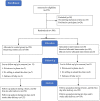Continuous non-locking vs. interrupted suturing techniques for the repair of episiotomy or second-degree perineal tears: A single-blind randomized controlled trial
- PMID: 37091272
- PMCID: PMC10113503
- DOI: 10.3389/fsurg.2023.1114477
Continuous non-locking vs. interrupted suturing techniques for the repair of episiotomy or second-degree perineal tears: A single-blind randomized controlled trial
Abstract
Objective: Perineal trauma is a serious and frequent problem after childbirth which is experienced by millions of women worldwide. The technique used for perineal repair may have an impact on pain and wound healing. The aim of the present study was to compare the continuous non-locking technique with interrupted suturing for the repair of episiotomy or second-degree perineal tears.
Methods: A single-blind randomized-controlled trial was conducted from October 2021 to August 2022 in Sina Hospital, Ahvaz, Iran. Three hundred women were selected and randomly assigned into control and intervention groups using block randomization technique. The main outcomes included pain and wound healing that were assessed using visual analog scale (VAS), as well as redness, edema, ecchymosis/bruising, discharge, and approximation scale (REEDA). The secondary outcomes were the use of analgesics, duration of perineal repair, material used for suturing, pain during urination and defecation, and resumption of sexual intercourse. The participants were followed up on the first and seventh days and in the 6th week postpartum. Mann-Whitney, Chi-square, and Generalized Estimating Equations (GEE) model were used for data analysis.
Results: Wound healing was significantly better in the continuous non-locking suture technique compared to the interrupted technique (β = -1.98; P > 0.0001). Women also experienced less pain in the continuous non-locking suture technique (β = -2.46; P > 0.0001). There was a reduction in the use of analgesics, the duration of perineal repair, and the material used for suturing in the continuous non-locking suturing technique as opposed to the interrupted method (P < 0.0001).The odds of pain during urination and defecation significantly reduced in women who underwent the continuous non-locking method (P < 0.001). Also, women in the continuous non-locking group resumed their sexual intercourse earlier (P < 0.0001).
Conclusion: The findings of this study revealed that use of continuous non-locking technique for suturing was associated with reduced perineal pain and improved wound healing. Furthermore, it was associated with a shorter duration of perineal repair, less suture material used, and less need for analgesics compared with the interrupted method. There is, however, need for more studies to confirm the results of the present study.Iranian registry for randomized controlled trials (Ref. ID: IRCT20190415043283N1).
Keywords: continuous non-locking suturing technique; episiotomy; interrupted suturing technique; perineal pain; wound healing.
© 2023 Faal Siahkal, Abedi, Iravani, Esfandiarinezhad, Dastoorpoor, Bakhtiari, Najafian, Sharifipour and Mohaghegh.
Conflict of interest statement
The authors declare that the research was conducted in the absence of any commercial or financial relationships that could be construed as a potential conflict of interest.
Figures
Similar articles
-
Perineal repair of media-lateral episiotomies and 2nd degree tears by midwives: A randomised controlled trial comparing three suture techniques.Int J Nurs Stud. 2020 Jun;106:103553. doi: 10.1016/j.ijnurstu.2020.103553. Epub 2020 Mar 3. Int J Nurs Stud. 2020. PMID: 32278106 Clinical Trial.
-
The Effect of Malva Sylvestris Cream on Episiotomy Pain and Healing: A Randomized Controlled Clinical Trial.Int J Community Based Nurs Midwifery. 2022 Oct;10(4):248-258. doi: 10.30476/IJCBNM.2022.95772.2082. Int J Community Based Nurs Midwifery. 2022. PMID: 36274662 Free PMC article. Clinical Trial.
-
Randomized Trial of 3 Techniques of Perineal Skin Closure During Second-Degree Perineal Laceration Repair.J Midwifery Womens Health. 2019 Sep;64(5):567-577. doi: 10.1111/jmwh.13020. Epub 2019 Aug 21. J Midwifery Womens Health. 2019. PMID: 31433108 Free PMC article. Clinical Trial.
-
[Perineal tears and episiotomy: Surgical procedure - CNGOF perineal prevention and protection in obstetrics guidelines].Gynecol Obstet Fertil Senol. 2018 Dec;46(12):948-967. doi: 10.1016/j.gofs.2018.10.024. Epub 2018 Nov 2. Gynecol Obstet Fertil Senol. 2018. PMID: 30392991 Review. French.
-
Postpartum Dyspareunia Following Continuous Versus Interrupted Perineal Repair: A Systematic Review and Meta-Analysis.Cureus. 2022 Sep 12;14(9):e29070. doi: 10.7759/cureus.29070. eCollection 2022 Sep. Cureus. 2022. PMID: 36259006 Free PMC article. Review.
Cited by
-
The PLUS study: efficacy of triclosan coated suture (VicrylPlus®) to reduce infection in primary suture of childbirth related perineal tears - a randomized controlled trial.Matern Health Neonatol Perinatol. 2025 May 5;11(1):13. doi: 10.1186/s40748-025-00211-0. Matern Health Neonatol Perinatol. 2025. PMID: 40320545 Free PMC article.
References
-
- Kettle C, Dowswell T, Ismail KM. Continuous and interrupted suturing techniques for repair of episiotomy or second-degree tears-Cochrane Database of Systematic Reviews-ISBN: 1465-1858 (2014).
-
- Melchor J, Bartha J, Bellart J, Galindo A, Miño M, Perales A. Episiotomy in Spain: data from 2006. Prog. en Obstet. y Ginecol. (2008) 51(9):559–63. 10.1016/S0304-5013(08)72329-X - DOI
-
- Pakpahan S, Sianturi E. The effectiveness of coleus amboinicus l. Leaves extract solution for grade II laceration of the perineal tears in postpartum mothers. Science Midwifery. (2022) 10(2): 1875–80. 10.35335/midwifery.v10i2.564 - DOI
-
- Blondel B, Alexander S, Bjarnadóttir RI, Gissler M, Langhoff-Roos J, Novak-Antolič Ž, et al. Variations in rates of severe perineal tears and episiotomies in 20 European countries: a study based on routine national data in Euro-Peristat Project. Acta Obstet Gynecol Scand. (2016) 95(7):746–54. 10.1111/aogs.12894 - DOI - PubMed
LinkOut - more resources
Full Text Sources


